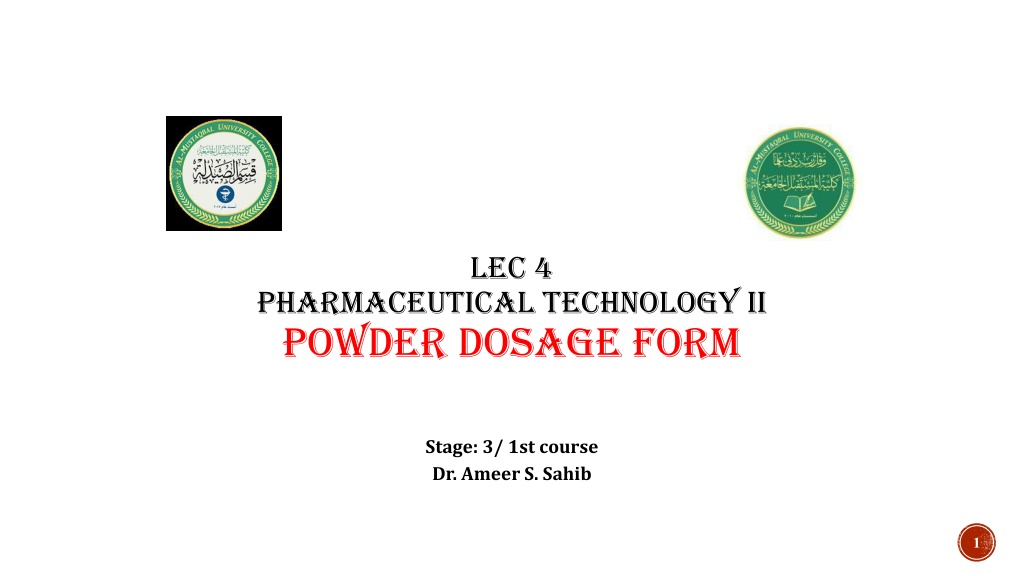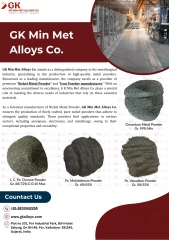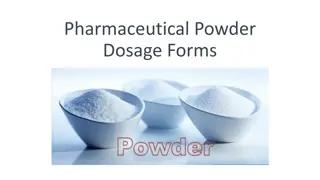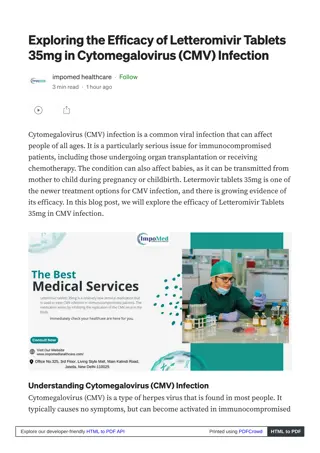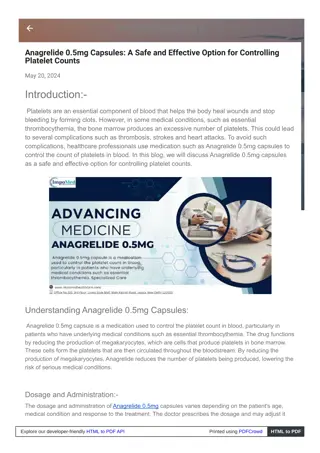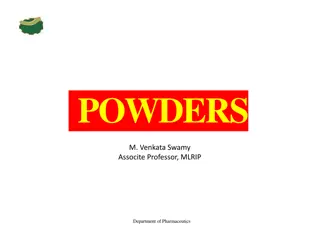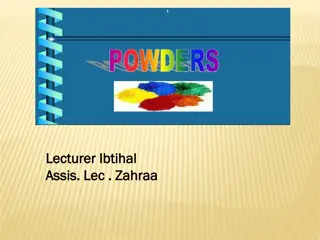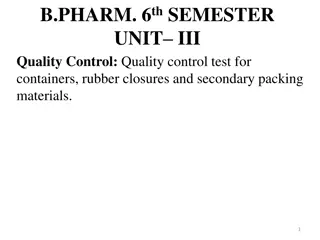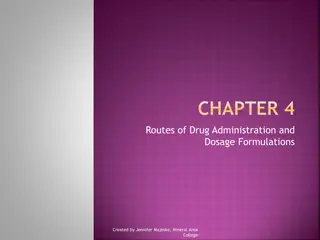Understanding Pharmaceutical Powders in Dosage Forms
Pharmaceutical powders play a vital role in various dosage forms, serving as carriers of active ingredients and enabling diverse administration routes. They are meticulously characterized for their physical and chemical properties before being utilized in medicinal preparations. Furthermore, the control of particle size is crucial for ensuring the effectiveness and quality of the final pharmaceutical product.
Download Presentation

Please find below an Image/Link to download the presentation.
The content on the website is provided AS IS for your information and personal use only. It may not be sold, licensed, or shared on other websites without obtaining consent from the author. Download presentation by click this link. If you encounter any issues during the download, it is possible that the publisher has removed the file from their server.
E N D
Presentation Transcript
lec 4 Pharmaceutical Technology II powder dosage form Stage: 3/ 1st course Dr. Ameer S. Sahib 1
Powder Most active and inactive pharmaceutical ingredients occur in the solid state as amorphous powders or as crystals of various morphologic structures. The term powder has more than one meaning in pharmacy. 1. It may be used to describe the physical form of a material, that is, a dry substance composed of finely divided particles. 2. It may be used to describe a type of pharmaceutical preparation, that is, a medicated powder intended for internal (i.e., oral powder) or external (i.e., topical powder) use. 2
Powders and granules Powders (as a dosage form) are mixtures of dry, finely divided drugs and/or chemicals that may be intended for internal or external use. Granules, which are prepared agglomerates of powdered materials, may be used per se for the medicinal value of their content, or they may be used for pharmaceutical purposes, as in making tablets 3
The use of powders a) Medicated powders for therapeutic effect (limited), b) The use of powdered substances in the preparation of other dosage forms is extensive. For example, powdered drugs may be blended with powdered fillers and other pharmaceutical ingredients to fabricate 1- solid dosage forms as tablets and capsules; 2- they may be dissolved or suspended in solvents or liquid vehicles to make various liquid dosage forms; 3- they may be incorporated into semisolid bases in the preparation of medicated ointments and creams. 4
Characterization of powders Before their use in the preparation of pharmaceutical products, solid materials first are characterized to determine their chemical and physical features, including: 1. Morphology 2. Purity 3. Solubility 4. Flowability 5. Stability 6. Particle size 7. Uniformity 8. Compatibility with any other formulation components 5
Particle size The adjustment and control of a drug and other materials powder's particle size; enable both the efficient production of a finished dosage form and the optimum therapeutic efficacy. United States Pharmacopeia (USP) uses these terms: very coarse, coarse, moderately coarse, fine, and very fine, which are related to the proportion of powder that is capable of passing through the openings of standard sieves of varying fineness in a specified period while being shaken, generally in a mechanical sieve shaker Sieves can be referred to either by their aperture size or by their mesh size (or sieve number). The mesh size is the number of wires per linear inch 6
Terminology of powders Very coarse (No. 8): All particles pass through a No. 8 sieve and not more than 20% pass through a No. 60 sieve. Coarse (No. 20): All particles pass through a No. 20 sieve and not more than 40% pass through a No. 60 sieve. Moderately coarse (No. 40): All particles pass through a No. 40 sieve and not more than 40% pass through a No. 80 sieve. Fine (No. 60): All particles pass through a No. 60 sieve and not more than 40% pass through a No. 100 sieve. Very fine (No. 80): All particles pass through a No. 80 sieve. There is no limit to greater fineness. 7
Particle size can influence a variety of important factors 1. Dissolution rate of particles intended to dissolve; drug micronization can increase the rate of drug dissolution and its bioavailability 2. Suspendability of particles intended to remain un-dissolved but uniformly dispersed in a liquid vehicle (e.g., fine dispersions have particles approximately 0.5 to 10 m) 3. Uniform distribution of a drug substance in a powder mixture or solid dosage form to ensure dose-to-dose content uniformity 4. Penetrability of particles intended to be inhaled for deposition deep in the respiratory tract (e.g., 1 to 5 m) 5. Lack of grittiness of solid particles in dermal ointments, creams, and ophthalmic preparations (e.g., fine powders may be 50 to 100 m in size) 8
Micromeritics Micromeritics is the science of small particles. It is the study of a number of characteristics, including: Particle size and size distribution, Shape Angle of repose, Porosity True volume, Bulk volume, Apparent density, Bulkiness 9
Determination methods of particle size 1. Sieving, in which particles are passed by mechanical shaking through a series of sieves of known and successively smaller size and the proportion of powder passing through or being withheld on each sieve is determined (range about 40 to 9,500 m, depending upon sieve sizes). 2. Microscopy In which sample particles are sized through the use of a calibrated grid background or other measuring device (range 0.2 to 100 m). 10
3.Sedimentation rate method In which particle size is determined by measuring the terminal settling velocity of particles through a liquid medium in a gravitational or centrifugal environment (range 0.8 to 300 m). Sedimentation rate may be calculated from Stokes' law. dx/dt = d2( i e)g/ 18 dx/dt is the rate of settling, d is the diameter of the particles, iis the density of the particle ( = Rho), e is the density of the medium, g is the gravitational constant, and is the viscosity of the medium ( = Eta) 11
Sedimentation cont.. Another method of particle size determination entails sedimentation using the Andreasen pipette, a special cylindrical container from which a sample can be removed from the lower portion at selected intervals. The powder is dispersed in a non- solvent in the pipette and agitated, and 20-mL samples are removed over time. Each 20-mL sample is dried and weighed. The particle diameters can be calculated from this equation: Where d is the diameter of the particles, h is the height of the liquid above the sampling tube orifice, is the viscosity of the suspending liquid, i - e is the density difference between the suspending liquid and the particles, g is the gravitational constant, and t is the time in seconds. 12
4. Light energy diffraction or light scattering, in which particle size is determined by the reduction in light reaching the sensor as the particle, dispersed in a liquid or gas, passes through the sensing zone (range 0.2 to 500 m). 5. Laser holography, in which a pulsed laser is fired through an aerosolized particle spray and is photographed in three dimensions with a holographic camera, allowing the particles to be individually imaged and sized (range 1.4 to 100 m) . 6. Cascade impaction. These methods may be used for the analysis of particle size and shape. For some materials, a single method may be sufficient; however, a combination of methods is frequently preferred to provide greater certainty of size and shape parameters. Most commercial particle size analyzers are automated and linked with computers for data processing, distribution analysis, and printout. 13
Flowability: Angle of repose Flowability: Angle of repose The angle of repose is a relatively simple technique for estimating the flow properties of a powder. It can easily be determined by allowing a powder to flow through a funnel and fall freely onto a surface. The height and diameter of the resulting cone are measured and the angle of repose is calculated from this equation: tan = h/r Where h is the height of the powder cone and r is the radius of the powder cone. 14
Example A powder was poured through the funnel and formed a cone 3.3 cm high and 9 cm in diameter. What is the angle of repose? tan = h/r = 3.3/4.5 = 0.73 arc tan 0.73 = 36.25 Angle of repose as an indicator of powder flow properties Angle of repose (degree) <20 20-30 30-34 34-40 >40 Type of flow Excellent Good Passable Poor Very poor 15
Flowability Powders with a low angle of repose flow freely, and powders with a high angle of repose flow poorly A number of factors determine the flow properties of powders, including: Shape : Spherical particles flow better than needles. Size : Very fine particles do not flow as freely as large particles. In general, particles in the size range of 250 to 2,000 m flow freely if the shape is amenable. Particles in the size range of 75 to 250 m may flow freely or cause problems, depending on shape and other factors. With most particles smaller than 100 m, flow is a problem. 16
Particle Size Reduction Reduction in particle size, increases the number of particles and the total surface area. The reduction in the particle size of a solid is accompanied by a great increase in the specific surface area of that substance. Comminution, reduction of the particle size of a solid substance to a finer state, is used to: 1. Facilitate crude drug extraction, 2. Increase the dissolution rates of a drug, 3. Aid in the formulation of pharmaceutically acceptable dosage forms, 4. Enhance the absorption of drugs. 17
Increase in the number of particles If a powder consists of cubes 1 mm on edge and it is reduced to particles 10 m on edge, what is the number of particles produced? 1 mm equals 1,000 m. 1,000/10 m = 100 pieces produced on each edge; that is, if the cube is sliced into 100 pieces on the x-axis, each 10 m long, 100 pieces result. If this is repeated on the y- and z-axes, the result is 100 100 100 = one million particles produced, each 10 m on edge, for each original particle 1 mm on edge. This can also be written as (102)3 = 106. 18
Increase in surface area What increase in the surface area of the powder is produced by decreasing the particle size from 1 mm to 10 m? The 1-mm cube has six surfaces, each 1 mm on edge. Each face has a surface area of 1 mm2. Because there are six faces, this is 6 mm2 surface area per particle. Each 10- m cube has six surfaces, each 10 m on edge. Each face has a surface area of 10 10=100 m2. Because there are six faces, this is 6 100 m2, or 600 m2 surface area per particle. Since 106 particles resulted from comminuting the 1-mm cube, each 10 m on edge, the surface area now is 600 106 m2, or 6 108 m2. To get every thing in the same units for ease of comparison, convert the 6 108 m2 into square millimeters as follows. Since there are 1,000 m/mm, there must be 1 million m2/mm2. This is more appropriately expressed as 106 m2/mm2, 19
Comminution of drugs A. On a small scale, (a mortar and pestle or slab and spatula) Trituration or comminution The pharmacist reduces the size of chemical substances by grinding with a mortar and pestle (as a result of pressure and attrition). A finer grinding action is accomplished by using a mortar with a rough surface (as a porcelain mortar) than one with a smooth surface (as a glass mortar). Levigation Used in small-scale preparation of ointments and suspensions to reduce the particle size and grittiness of the added powders. A paste is formed by combining the powder and a small amount of liquid (the levigating agent) in which the powder is insoluble. The paste is then triturated, reducing the particle size. The levigated paste may then be added to the ointment base and the mixture made uniform and smooth by rubbing them together with a spatula on the ointment tile (slab). Water, mineral oil and glycerin are commonly used levigating agents 20
B. On a large scale Various types of mills and pulverizers may be used to reduce particle size. Fitz Mill comminuting machine with a product containment system. Through the grinding action of rapidly moving blades in the comminuting chamber, particles are reduced in size and passed through a screen of desired dimension to the collection container. The collection and containment system used to: Protects the environment from chemical dust, Reduces product loss, Prevents product contamination. Pulverization by intervention It is reduction of particle size with the aid of a second agent which can be readily removed from the pulverized product. This term applies to particle size reduction of camphor, which is otherwise difficult to triturate. It may be readily triturated when a few drops of alcohol or other volatile solvent are added. The pulverized camphor is readily recovered as the solvent evaporates. 21
Drying processes These processes may be used to prepare powders for dosage forms include sublimation, freeze drying and spray drying. Spray drying: Is a process for converting solution or suspensions into dry, free-flowing powders in a single drying step. The solution or suspension is atomized or sprayed into an enclosed chamber into which heated air is also introduced. The atomization process produces very fine, generally spherical droplets with large surface areas that dry almost instantaneously. Materials sensitive to heat and/or oxidation can be spray dried without degradation. These include heat- sensitive materials such as pepsin and vitamins A and D, and easily oxidized materials such as epinephrine and ascorbic acid. 22
Freeze Drying: (Drying by sublimation, lyophillization) It refers to the removal of water by sublimation from frozen products at low temperatures. It is time consuming method. Freeze drying is usually carried out in temperature range of 10 to 40 C. It is used to dry biological products such as blood serum, plasma, certain antibiotics such as penicillin, and other substances that are heat-labile and cannot be dried by the usual application of heat. 23
Blending of powders When two or more powdered substances are to be combined to form a uniform mixture, it is best to reduce the particle size of each powder individually before weighing and blending. Depending on the nature of the ingredients, the amount of powder, and the equipment, powders may be blended by: a) Spatulation , b) Trituration , c) Sifting, d) Tumbling. 24
A- Spatulation Spatulation is blending small amounts of powders by movement of a spatula through them on a sheet of paper or an ointment tile. It is not suitable for large quantities of powders or for powders containing potent substances, because homogeneous blending is not as certain as other methods. Very little compression or compacting of the powder results from spatulation, which is especially suited to mixing solid substances that form eutectic mixtures (or liquefy) when in close and prolonged contact with one another. Substances that form eutectic mixtures when combined include phenol, camphor, menthol, thymol, aspirin, phenyl salicylate, and other similar chemicals. To diminish contact, a powder prepared from such substances is commonly mixed in the presence of an inert diluent, such as light magnesium oxide or magnesium carbonate, to separate the troublesome agents physically. 25
B- Trituration Trituration may be employed both to comminute and to mix powders. If simple admixture is desired without the special need for comminution, the glass mortar is usually preferred. When a small amount of a potent substance is to be mixed with a large amount of diluent, the geometric dilution method is used to ensure the uniform distribution of the potent drug. This method is especially indicated when the potent substance and other ingredients are the same color and a visible sign of mixing is lacking. By this method, the potent drug is placed with an approximately equal volume of the diluent in a mortar and is mixed thoroughly by trituration. Then, a second portion of diluent equal in volume to the mixture is added and the trituration repeated. This process is continued by adding an equal volume of diluent to the powder mixture and repeating this until all of the diluent is incorporated. Some pharmacists add an inert colored powder to the diluent before mixing to permit visual inspection of the mixing process. (to ensure uniform distribution). 26
C- Sifting Powders may also be mixed by passing them through sifters like those used in the kitchen to sift flour. Sifting (sieving) results in a light, fluffy product. This process is not acceptable for the incorporation of potent drugs into a diluent powder. D- Tumbling Another method of mixing powders is tumbling the powder in a rotating chamber. Special small-scale and large-scale motorized powder blenders mix powders by tumbling them Mixing by this process is thorough but time consuming. Such blenders are widely employed in industry, as are mixers that use motorized blades to blend powders in a large vessel. 27
Problems associated with particle size reduction Segregation: is an undesirable separation of the different components of the powder mixture (blend) due to differences in density and size. Segregation may occur by: Sifting or percolation Fine particles tend to sift or percolate through coarse particles and end up at the bottom of the container and actually lift the larger particles to the surface. Air entrapment (fluidization), Fine, aerated powders with differences in particle size or density may result in a striation pattern and may occur during powder transfer. Particle entrapment (dusting) Dusting occurs when the finer, lighter particles remain suspended in air longer and do not settle as quickly as the larger or denser particles. 28
MEDICATED POWDERS Some medicated powders are intended to be used 1- Internally. Some powders are intended to be inhaled for local and systemic effects. Other dry powders are commercially packaged for constitution with a liquid solvent or vehicle, Some for administration orally, are taken orally after mixing with water or in the case of infants in their infant formulas, others for use as an injection, others for use as a vaginal douche, 2- Externally Medicated powders for external use are dusted on the affected area from a sifter-type container or applied from a powder aerosol. Powders intended for external use should bear a label marked EXTERNAL USE ONLY or a similar label. Examples, antifungal and antibacterial topical powder. 29
Medicated powders for oral use Medicated powders for oral use may be intended for local effects (e.g., laxatives) or systemic effects (e.g., analgesics), and may be preferred to counterpart tablets and capsules by patients who have difficulty swallowing solid dosage forms. The doses of some drugs are too bulky to be formed into tablets or capsules of convenient size, so they may be administered as powders. For administration, they can be mixed with a liquid or soft food. Powders taken orally for systemic use may be expected to result in faster rates of dissolution and absorption than solid dosage forms, because there is immediate contact with the gastric fluids; however, the actual advantage in terms of therapeutic response may be negligible or only minimal, depending on the drug release characteristics of the counterpart products. 30
Some medications, notably antibiotics for children, are intended for oral administration as liquids but are relatively unstable in liquid form. They are provided to the pharmacist by the manufacturer as a dry powder or granule for constitution with a specified quantity of purified water at the time of dispensing. Under labeled conditions of storage, the resultant product remains stable for the prescribed period of use, generally up to 2 weeks. A primary disadvantage of the use of oral powders is the undesirable taste of the drug. 31
Aerosol powders Some medicated powders are administered by inhalation with the aid of dry- powder inhalers, which deliver micronized particles of medication in metered quantities Most of these products are used in the treatment of asthma and other bronchial disorders that require distribution of medication deep in the lung. To accomplish this, the particle size of the micronized medication is prepared in the range of 1 to 6 m in diameter. In addition to the therapeutic agent, these products contain inert propellants and pharmaceutical diluents, such as crystalline alpha-lactose monohydrate, to aid the formulation's flow properties and metering uniformity and to protect the powder from humidity. They administered in a metered-valve container that apply a specific dose (Each dose is delivered through the mouthpiece upon activation of the aerosol unit's valve) or can use a powder blowers or insufflators 32
Powder blowers or insufflators may be used to deliver dry powders to various parts of the body, e.g., nose, throat, lung, vagina. 33
Dispensing of powders (Bulk and divided powders) Medicated powders may be provided to the patient in bulk or may be divided into unit-of- use packages. Some powders are packaged by manufacturers, whereas others are prepared and packaged by the pharmacist. 34
Bulk powder 1. Dispensing powder medication in bulk quantities is limited to non-potent substances. 2. Patients should be educated about appropriate handling, storage, measurement, and preparation of bulk powder prescription and nonprescription products in addition to the customary counseling at the time of dispensing or purchase. Generally, these products are stored at room temperature in a clean, dry place. These products should be kept out of the reach of children. 3. Patients should be instructed how to measure the appropriate amount of the powder and be told the type and volume of liquid or vehicle to use to deliver the medication consistent with package and/or physician instructions. 35
Divided Powders After a powder has been properly blended, it may be divided into individual dosing units based on the amount to be taken or used at a single time. Each divided portion of powder may be placed on a small piece of paper (Latin chartula; abbrev. chart.; powder paper) that is folded to enclose the medication. Examples, headache powders (e.g., Aspegic powders), powdered laxatives (e.g., psyllium mucilloid, Fybrogel ), douche powders (e.g., Massengill powder packets). 36
Divided powders may be prepared by the pharmacist There are two main methods according to the drug potency: Weighting method: weigh each portion of powder separately before enfolding in a paper (for potent drugs) (The smallest amount of powders in a packet is 100mg). Block-and-divide method: approximate method, used only for non-potent drugs, the pharmacist places the entire amount of the prepared powder on a flat surface such as a porcelain or glass plate, pill tile, or large sheet of paper and, with a large spatula (or ruler), forms a rectangular or square block of the powder having a uniform depth. Then, using the spatula, the pharmacist cuts into the powder lengthwise and crosswise to delineate the appropriate number of smaller, uniform blocks, each representing a dose or unit of medication. Each of the smaller blocks is separated from the main block with the spatula, transferred to a powder paper, and wrapped. 37
Powder paper The powder papers may be of any size convenient to hold the amount of powder required, but the most popular commercially available sizes are 2.75 3.75 in., 3 4.5 in., 3.75 5 in., and 4.5 6 in.. The papers are: (a) Simple bond paper; (b) Vegetable parchment, a thin, semi-opaque paper with limited moisture resistance; is a cellulose-based composite that has been processed to give it additional properties like non-stickiness, grease resistance, and resistance to humidity. (c) Glassine, a glazed, transparent paper, also with limited moisture resistance; (d) Waxed paper, a transparent waterproof paper. 38
The selection of the type of paper is based primarily on the nature of the powder. If the powder contains hygroscopic or deliquescent materials, waterproof or waxed paper should be used. In practice, such powders are double wrapped in waxed paper, and then for aesthetic appeal they are wrapped in bond paper. Glassine and vegetable parchment papers may be used when only a limited barrier against moisture is necessary. Powders containing volatile components should be wrapped in waxed or glassine papers. Powders containing neither volatile components nor ingredients adversely affected by air or moisture are usually wrapped in a white bond paper. 39
Paper folding 1. Place the paper flat on a hard surface and fold toward you a uniform flap of about 0.5 in. of the long side of the paper. To ensure uniformity of all of the papers, this step should be performed on all the required papers concurrently, using the first folded paper as the guide (A). 2. With the flap of each paper away and on top, place the weighed or divided powder in the center of each paper. 3. Being careful not to disturb the powder excessively, bring the lower edge of the paper upward and tuck it into the crease of the flap (B) 4. Grasp the flap, press it down upon the tucked-in bottom edge of the paper, and fold again with an amount of paper equal to the size of the original flap (0.5 in.) (C). 5. Pick up the paper with the flap on top, being careful not to disturb the position of the powder, and place the partially folded paper over the open powder box (to serve as the container) so that the ends of the paper extend equally beyond the sides (lengthwise) of the open container. Then, press the sides of the box slightly inward and the ends of the paper gently down along the sides of the box to form a crease on each end of the paper. Lift the paper from the box and fold the ends of the paper along each crease sharply so that the powder cannot escape (D). 6.Place the folded paper in the box so that the double-folded flaps are at the top, facing you, and the ends are folded away from you (E). 40
Granules Granules are prepared agglomerates of smaller particles of powder. They are irregularly shaped but may be prepared to be spherical. They are usually in the 4- to 12-mesh sieve size range, although granules of various mesh sizes may be prepared depending upon their application. Examples KLACID granules for oral suspension (clarithromycin), Augmentin ES-600 (amoxicillin/ clavulanate potassium) Uricol granules. The granules are measured and mixed with water or other beverages, sprinkled on food, or eaten plain. Granulations of effervescent products may be compressed into tablet form, as Zantac EFFER dose tablets. Also (Multivitamins) effervescent granules and tablets are dissolved in water before use. 41
Preparation of granules Wet method Wet method is to moisten the powder or powder mixture and then pass the resulting paste through a screen of the mesh size to produce the desired size of granules. The granules are placed on drying trays and are dried by air or under heat. The granules are periodically moved about on the drying trays to prevent adhesion into a large mass. Another type of wet method is fluid bed processing, in which particles are placed in a conical piece of equipment and are vigorously dispersed and suspended while a liquid excipient is sprayed on the particles and the product dried, forming granules or pellets of defined particle size 42
Dry method for granulation The dry granulation method may be performed in a couple of ways. By one method, the dry powder is passed through a roll compactor and then through a granulating machine. An alternative dry method, termed slugging, is the compression of a powder or powder mixture into large tablets or slugs on a compressing machine under 8,000 to 12,000 lb of pressure, depending on the physical characteristics of the powder. The slugs are generally flat-faced and are about 2.5 cm (1 in.) in diameter . The slugs are granulated into the desired particle size, generally for use in the production of tablets. The dry process often results in the production of fines, that is, powder that has not agglomerated into granules. These fines are separated, collected, and reprocessed 43
Effervescent granulated salts Effervescent salts are granules or coarse to very coarse powders containing a medicinal agent in a dry mixture usually composed of sodium bicarbonate, citric acid, and tartaric acid. When added to water, the acids and the base react to liberate carbon dioxide, resulting in effervescence. The resulting carbonated solution masks undesirable taste of any medicinal agent. Acids + Sod bicarb ------H2O-------> Salt + CO2 44
Q: why using granules rather than fine particles? Using granules or coarse particles of the mixed powders rather than small powder particles decreases the rate of solution and prevents violent and uncontrollable effervescence. Sudden and rapid effervescence could overflow the glass and leave little residual carbonation in the solution. Q: why both citric and tartaric acid used and not one of them? Using a combination of citric and tartaric acids rather than either acid alone avoids certain difficulties. When tartaric acid is used as the sole acid, the resulting granules readily lose their firmness and crumble. Citric acid alone results in a sticky mixture difficult to granulate. 45
Fusion or dry method In the fusion method, the one molecule of water present in each molecule of citric acid acts as the binding agent for the powder mixture. Before mixing the powders, the citric acid crystals are powdered and then mixed with the other powders of the same sieve size to ensure uniformity of the mixture. The sieves and the mixing equipment should be made of stainless steel or other material resistant to the effect of the acids. The mixing of the powders is performed as rapidly as is practical, preferably in an environment of low humidity to avoid absorption of moisture and a premature chemical reaction. After mixing, the powder is placed on a suitable dish in an oven at 34 C to 40 C. During the heating process, an acid-resistant spatula is used to turn the powder. The heat releases the water of crystallization from the citric acid, which in turn dissolves a portion of the powder mixture, setting the chemical reaction and consequently releasing some carbon dioxide. 46
This causes the softened mass of powder to become somewhat spongy, and when it has reached the proper consistency (as bread dough), it is removed from the oven and rubbed through a sieve to produce granules of the desired size (Screening). a No. 4 sieve produces large granules, a No. 8 sieve prepares medium size granules, and a No. 10 sieve prepares small granules. The granules are dried at a temperature not exceeding 54 C and are immediately placed in containers and tightly sealed. Preparation steps Citric acid powdering Powders with citric acid mixing and sieving Heating in oven (make spongy mass) Screening in specified sieve Drying Packaging 47
Wet Method The wet method differs from the fusion method in that the source of binding agent is not the water of crystallization from the citric acid but the water added to alcohol as the moistening agent, forming the pliable mass for granulation. In this method, all of the powders may be anhydrous as long as water is added to the moistening liquid. Just enough liquid is added (in portions) to prepare a mass of proper consistency; then the granules are prepared and dried in the same manner as described. 48
